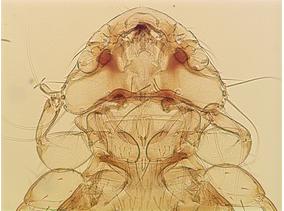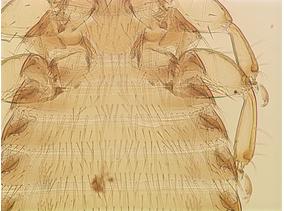You are here
Lice
Amblycera
Nomenclature
-
Class: InsectaOrder: Phthiraptera
Media
SUMMARY
1.0 – 11 mm long. Head large and developed laterally, often projecting posteriorly over prothorax. Tentorium complete with exception of dorsal arms. Cranial plates and sutures often poorly developed. Antennae capitate, four- or usually five-segmented with the third segment (first flagellomere) pedunculate. Second and third flagellomeres bear sensilla. Eyes variable, may be large, reduced or absent. Maxillary palps filiform and well developed. Mandibular mouthparts (usually asymmetric) that articulate horizontally with the head. Thoracic segments large, well developed, and ellipsoid. Pronotum always separate. Meso- and metanotum variably fused or separate. Single pair of ‘mesothoracic’ spiracles present on prothorax. Legs large and variable, particularly with respect to the tarsal segments and their angle of connection with the thorax. Paired pretarsal claws present except in the family Gyropidae that is not known from Greenland. Abdomen shape large and variable, typically broad and ‘fat’. Eight pregenital segments, although segments I and II are sometimes fused. In adults the ninth visible segment bears the genital apparatus. Segments range from highly sclerotized to membranous. Five or usually six pairs of abdominal spiracles. The post spiracular seta of at least one abdominal segment with two minute associated setae. External genitalia usually well developed in both sexes, often with distinct gonopophyses arising as lobes on some females. Hosts in Greenland: Birds






